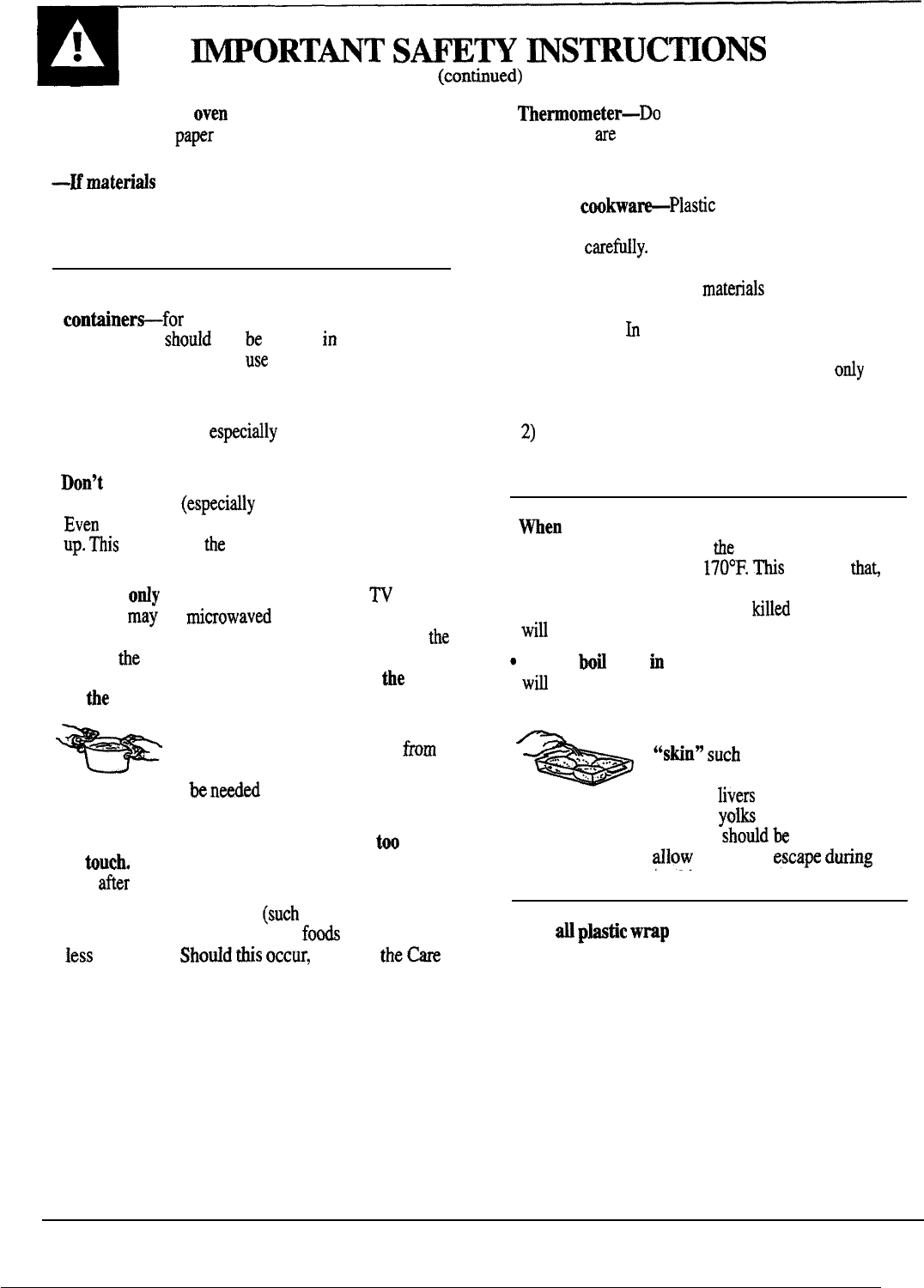
~ORT~T
S~H
mSTRUC~ONS
(contiued)
—Do not use the
oven
for storage purposes.
Do
not leave
p~r
products, cooking utensils
or food in the oven when not in use.
—E
materhds
inside oven should ignite,
keep
oven door closed, turn oven off, and disconnect
power cord, or shutoff power at the fuse or
circuit breaker panel.
●
Some products such as whole eggs and sealed
container~for
example, closed jars-will
explode and
should
not
be
heated
in
this
microwave oven. Such
use
of the microwave
oven could result in injury.
●
Avoid heating baby food
in glass jars, even
without their lids;
especirdly
meat and egg
mixtures.
●
Don’t
defrost frozen beverages
in narrow
necked bottles
(especi&ly
carbonated beverages).
Even
if the container is opened, pressure can build
up.
~is
can cause
the
container to burst, possibly
resulting in injury.
●
Use foil ody as directed in this book.
~
dinners
may
be
rnimowaved
in foil trays less than
3/4” high; remove the top foil cover and return
the
tray to
the
box. When using foil in the microwave
oven,
keep it at least 1 inch away from
the
sides
of
the
oven.
●
Cookware may become hot
because of heat transferred
from
the heated food. Pot holders may
be
needed
to handle the
cookware.
*Sometimes?
the turntable can become
too
hot
to
touch.
Be careful touching the turntable during
and
after
cooking.
●
Foods cooked in liquids
(such
as pasta) may tend
to boil over more rapidly than
foods
containing
less
moisture.
Shodd
tiis
occur,
refer to
the&
and Cleaning section(s) for instructions on how to
clean the inside of the oven.
A
●
~ermometer-Do
not use a thermometer in
food you
me
microwaving unless the thermometer
is designed or recommended for use in the
microwave oven.
●
Plastic
cookwa-Plastic
cookware designed
for microwave cooking is very useful, but should
be used
care~ly.
Even microwave-safe plastic
may not be as tolerant of overcooking conditions
as are glass or ceramic materi~ and may soften
or char if subjected to short periods of
overcooking.
b
longer exposures to overcooking,
the food and cookware could ignite. For these
reasons: 1) Use microwave-safe plastics
ordy
and use them in strict compliance with the
cookware manufacturer’s recommendations.
2)
Do not subject empty cookware to
microwaving. 3) Do not permit children to use
plastic cookware without complete supervision.
●
men
cooking pork,
follow the directions
exactly and always cook
the
meat to an internal
temperature of at least
170°F.
~s
assures
tha~
in the remote possibility that trichina maybe
present in the meat, it will be
killed
and meat
wi~
be safe to eat.
*
Do not
boti
eggs
in
a microwave oven. Pressure
win
build up
inside egg yolk and will cause it to
burst, possibly resulting in injury.
-
●
Foods with unbroken outer
“skin”
such
as potatoes,
sausages, tomatoes, apples,
chicken
Iivers
and other giblets,
and egg
yo~
(see previous
caution)
shodd
be
pierced to
+Iow
steam to
escape
during
cooking.
●
Not
4
phtic
wmp
is suitable for use in
microwave ovens.
Check the package for
proper use.


















